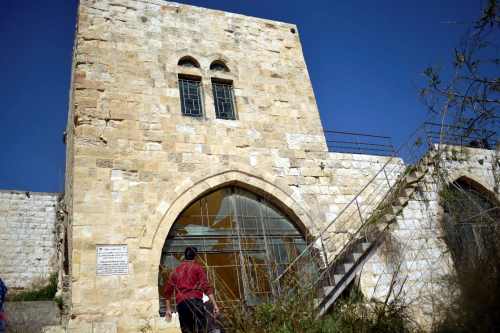Burin (Yitzhar), Huwwara
Changes at Jebel Isma’il that apparently were made by the National Parks Authority to ensure safe passage to the maqam’s prayer room. No signage provides the site’s name or indicates that it is holy to Moslems.
We had made an appointment to meet the deputy mayor of Huwwara. When we arrived we were told he couldn’t meet us. He referred us to the city engineer. We arranged to meet at 13:00.
We drove to the Huwwara checkpoint. Traffic flowed. From there we went up to Jebel Isma’il and to the maqam among the pistachio trees to see what had changed at this appropriated location since our last visit five months ago, and at the maqam where two families that had settled there had been removed. At this season of the year the trees, which have lost their leaves during the winter, are budding. The site is neglected but there are signs settlers have been here.
Of greater concern are the indications we believe are from the Nature Preserves Authority. A sign has been removed at the stairs to the maqam’s roof warning of an unstable structure. Plaster was repaired in the prayer room, which had been roughly reinforced with concrete. Posts have been placed on the way to the maqam to prevent access by vehicles. We should note no signage indicates the location’s name: Jebel Abu Isma’il and maqam Abu Isma’il. May we assume they’re trying to conceal its Palestinian cultural heritage from visitors?
Archaeological remains are visible on the hills surrounding the maqam. The ancient buildings should be restored, the remains investigated, the site restored, to again permit Palestinians from the area and their families to enjoy the natural setting, the water, the shade trees and the maqam where they would meet and pray. And water their flocks of sheep.
Although Jebel Abu Isma’il is near the Beracha settlement, it’s not included in its municipal area. There’s no physical barrier like at the maqams within Yitzhar and Alon Moreh. Palestinians are not formally forbidden to go up to the Jebel, but they nevertheless avoid going there despite their strong desire to do so. They fear the armed settlers who harass them.
Down the hill, near the water source, is a structure the settlers have erected, brightly painted, apparently serving as a shelter for a miqveh they created. For men only. We met a settler shouldering a towel who had emerged from a parked car. It’s obvious to him the site belongs to the adjacent Beracha settlement.
He lives on Hill 851 in Itamar. He claimed relations with the residents of Yanun were normal. No disturbances. He has a story to tell, to show how good things are, about an incident in which Palestinians from Awwarta harassed women from Yanun and people from Itamar rescued them. As if to compensate for the outrages occurring there daily.
In Huwwara, before the meeting, a passerby who had recognized us as MachsomWatch members asked us to arrange a work permit for him in Israel. He doesn’t know why he’s blacklisted. We’ll give him Sylvia’s phone number.
The engineer took us to the old part of the town, to an ancient building that was restored in 2008 by Riwaq. The goal is to turn it into a community center. That requires an investment by the community as well, to maintain the building and to run programs for the public. The structure appears abandoned and neglected. There are signs of vandalism. Attractive doors with Belgian profile metalwork and broken window panes. Neglect and rubbish inside.
Buildings such as this usually offer the community activities for children and adults, provide space for meetings and various other events, like we saw and reported on during our shift in Ni’ilin.
The engineer has a request – to obtain a donation for renovating the ancient structure.
Nearby is a sports center and basketball court. The court is bordered on three sides by straight walls four meters high, hewn from the hill. We think there was once an ancient quarry there which created the flat surface.
Before driving back to the Rosh Ha’ayin train station, we stopped for a brief visit with D., our friend from Burin. She’s a social activist. She’s hosting in her mother’s home young people from abroad who’ve come to help the villagers with the olive harvest. She doesn’t let her own children participate in the harvest for fear of the settlers.
 |
|
|
|
 |

 |

